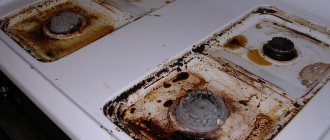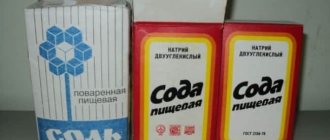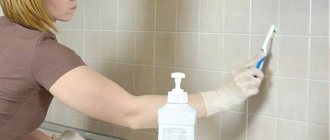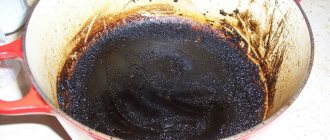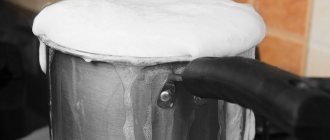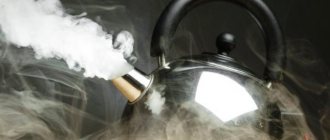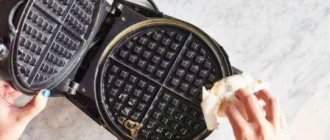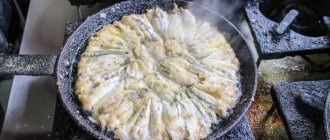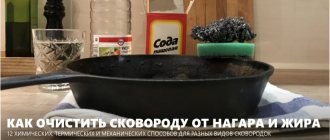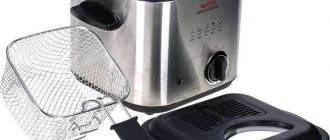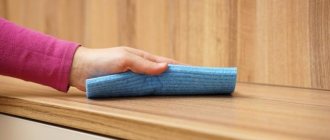Modern kitchens are equipped with appliances that make a woman’s work easier, but she doesn’t always have enough strength to wash dishes and utensils. If you bake regularly, but wash the baking sheet from time to time, the formation of soot cannot be avoided. Sugar and fats under the influence of high temperatures turn into a durable black mass that settles even on non-stick cookware.
We'll tell you how to clean a baking sheet from carbon deposits at home, and what methods can be used. You'll learn the best ways to clean aluminum, glass, and ceramic cookware and what products are not suitable for nonstick pans.
Cleaning with special products
Using chemical cleaners, you can deal with carbon deposits on all types of baking sheets, including non-stick ones. The main thing is that the product does not contain caustic alkalis or acids. To reduce the degree of negative impact, use the instructions.
- Use paper towels to remove grease and food residue.
- Apply liquid, gel or powder to the surface and wait 20 minutes.
- If there are dried particles of the dish, soak the baking sheet in warm water.
- Wipe the surface. Aluminum and stainless steel with a sponge, and non-stick and ceramic with a soft sponge.
- Rinse generously with clean water and wipe dry.
Is it difficult to clean a heavily soiled baking tray?
Not really
Using household chemicals, you can wash the baking sheet even from old fat.
Follow safety precautions. Wash dishes using rubber gloves and make sure that all the product is thoroughly rinsed off. Do not use chemicals to clean silicone baking trays.
Precautionary measures
Try not to put off cleaning the oven; this is the main condition for successful cleaning. While cooking, protect the oven walls from splashes of fat by covering the food with a lid or foil. Enterprising housewives, before baking fatty pieces of fish or meat, place foil on the walls of the oven, and after cooking, remove it, leaving the inside of the oven clean.
As for cleaning precautions, use rubber gloves. Citric acid and aggressive chemicals leave burns on the hands, causing cracks and painful ulcers
When pouring steam into the oven, carefully hold the container with boiling water and open the door. Steam escaping from the cabinet may cause thermal burns.
Whichever cleaning option you choose, after it, rinse the walls several times with plain water to remove the smell and excess detergent. Otherwise, you risk eating chicken that tastes like soda, fish that tastes like dishwashing detergent, and vegetables that taste like soap.
The article has been verified by the editors
High temperature cleaning
Another method that is suitable for cleaning a baking sheet from carbon deposits. Its essence lies in the destructive effect of steam and high temperature on various contaminants.
To clean the pan, follow the following sequence:
- pour a glass or two of water;
- add a tablespoon of vinegar or a squeeze of soda;
- Light the oven and place the baking sheet in it for 30-40 minutes.
After this treatment, the dishes can be washed with a regular brush. The method helps to remove even old plaque, but is not suitable for cleaning Teflon and silicone.
Don't forget to turn on the hood or open the window. Vinegar and baking soda create a specific odor when heated, so it is better to provide an influx of fresh air.
Baking soda
Using this product, you can only wash off fresh stains that have not had time to dry.
After cooking, you should immediately use baking soda and hydrogen peroxide, and not wait until the time or desire appears. You will need 100 grams of soda, 1 tsp. dishwashing detergent and 2 tbsp. l. hydrogen peroxide.
How to clean a baking tray:
- Peroxide, baking soda and detergent must be mixed well. You should get a homogeneous white mixture.
- Apply the composition to dirty dishes and wait 15 minutes.
- Use a hard sponge to clean the surfaces of the sheet from carbon deposits.
- At the end, you need to wash off all the dirt with water and wipe the dishes with a dry towel.
If you cannot get rid of stuck dirt this way, it is recommended to use another option.
Old fat is removed as follows: one pack of soda is poured into the product, poured with hot water for 3 hours. Then cleaned.
Cleaning with folk remedies
If you advocate a healthy lifestyle and are afraid that chemicals will not wash off, you can clean the baking sheet from burnt fat using folk remedies. When used correctly, they do not damage surfaces and do not cause harm to health.
Soda and vinegar
Using this method, you can kill two birds with one stone: clean the baking sheet itself and the inside of the oven from soot and grease. The combination of soda and vinegar allows you to remove even old dirt on metal, stainless steel and glass surfaces.
The procedure is extremely simple:
- Use a wooden spatula to remove any remaining food.
- Rinse the pan.
- Pour water up to the edge of the rim.
- Add 2 tablespoons of soda and the same amount of vinegar.
- Place the baking sheet in the oven.
Make sure that the water does not boil away, otherwise the soot will become stronger and you will have to throw out the pan. At the final stage, wash the sheet with dishwashing detergent and rinse with water.
Baking soda and hydrogen peroxide
If you don’t know how to wash off burnt sugar or jam, then this method is for you. With the help of hydrogen peroxide, you can remove even stubborn stains; you just need to boil 2 bottles of the solution and pour the liquid into a baking tray. Wait until the sheet cools down and wash it like regular dishes.
The second recipe can be used to clean glass and ceramic surfaces. It can also remove carbon deposits from the outside of baking sheets and non-stick pans.
- Mix baking soda with peroxide to obtain a creamy consistency.
- Spread a thin layer onto a dirty baking sheet.
- Wait half an hour.
Wash off the soda along with the carbon deposits and be amazed at the results. You can also clean pots, cups and other kitchen utensils.
Coca-Cola to the rescue
Not only a holiday will come to you, but also purity. The drink copes well with various contaminants, including old grease and soot. Application is simple:
- rinse the baking sheet from food residues;
- pour soda along the edges of the sides;
- wait two hours and wash with a sponge.
Instead of Coca-Cola, you can use Pepsi, Fanta or Sprite - the effect will be similar. And to strengthen it, boil the problem leaf for 10 minutes over low heat - the result will amaze you.
Ammonia
The last recipe is a folk one and is not inferior in its ability to remove carbon deposits to complex chemical agents. Among the disadvantages, long-term use is noted - you will notice the first result only the next day.
Pour a bottle of ammonia onto a baking sheet and spread it over the surface with a sponge. Place the leaf on the balcony or in the yard to escape the pungent odor. Wait 12 hours, then wash with normal detergents and hot water. Ammonia, which is part of ammonia, breaks down even stubborn fatty stains.
Tips for preventing grease from forming on the baking sheet surface
The easiest option to avoid problems with contamination is to use foil or special paper for baking. It is better to wash the baking sheet immediately after preparing the dish. If time is running out and you can’t wash the dishes on time, you should at least fill it with plain water.
One of the most effective means for cleaning carbon deposits is laundry soap.
Otherwise, you can choose one of the following methods to clean the pan. Don't forget about your hands; it is recommended to use gloves.
It is better to wash off leftover food and fat immediately. If time does not allow, you need to soak the dishes in hot water with added detergent.
Cleaning Recommendations
If you don't know how to clean a glass pan, read this section first. We will talk about nuances that not every housewife knows.
For example, advertised gels for burnt fat can only be used on stainless steel cookware.
But first things first.
Cleaning a glass or ceramic baking tray
Glass, ceramics, and enamel are fragile materials that are susceptible to mechanical stress, temperature changes, and aggressive compounds. Most methods that are suitable in other cases cannot be used here. How to remove carbon deposits?
Using soaking and mustard. Despite its apparent simplicity, the method is highly effective. When used correctly, mustard can remove grease from a baking sheet or frying pan in a few hours.
- Sprinkle mustard on the bottom of the leaf.
- Pour boiling water and leave everything to soak overnight.
- Wash off the grease with Fairy or Myth.
Rinse thoroughly and wipe dry. Instead of mustard powder, you can use soda and salt mixed in a 1:1 ratio.
Cleaning the aluminum baking tray
An aluminum baking tray can be cleaned with hydrogen peroxide, salt, mustard powder and boiling. The main thing is not to use vinegar and ammonia. If the remedies do not help, use the recipe.
- Sprinkle salt on the sheet in a 5 mm layer.
- Preheat the oven to 100°C.
- Place a baking tray to heat the salt.
- As soon as it turns brown, remove the sheet and let it cool.
- Rinse with warm water.
If necessary, the procedure can be repeated. Aluminum sheets can also be cleaned with dry soda, Pemolux powder and oven ash.
Silicone and Teflon baking trays
Silicone and Teflon baking sheets are very scrupulous in care, they are “afraid” of abrasives, caustic chemicals and alkalis. To clean them from carbon deposits, use a mild cleaning chemical that has a neutral environment.
Cleaning with “Extra” salt will also help.
- Remove pieces of fat and food with a wooden spatula.
- Add a layer of salt and wait half an hour.
- Pour 2-3 drops of neutral detergent and place a baking sheet or frying pan under running water.
If this does not help, you can soak the dishes in warm water for 12 hours, then repeat the procedure.
How to properly clean baking trays
Typically, baking trays are made of heat-resistant glass or aluminum, and the coating can be Teflon or enameled. Each of these materials has its own characteristics that you need to remember when choosing a cleaning method.
REFERENCE! The surface of the baking sheet can be damaged if you choose the wrong product or use abrasive brushes. This will ruin the appearance of the cookware, and the food cooked in it will begin to burn.
To keep your baking sheet in excellent condition, follow these tips:
- do not clean glass or enamel dishes with a metal sponge, otherwise scratches will appear on the surface, in which dirt will subsequently accumulate;
- powder with an abrasive composition cannot be used to clean glassware or enamel for the same reason;
— food residues from the aluminum baking sheet can be easily removed using a wooden spatula;
- to clean any baking tray faster and easier, you must first fill it with water, preferably warm, to which detergent has been added.
REFERENCE! It is best to clean and wash the sheets immediately after cooking food on them, then the residues will not have time to dry there.
Preventing carbon deposits
Sometimes dishes become dirty to such an extent that it is useless to clean them; it is better to buy new ones. To prevent this from happening, follow some simple rules.
- Always line the bottom and sides with parchment paper or foil, depending on the dish you are preparing.
- Wash dishes immediately before the grease hardens.
- If this is not possible, soak the baking sheet overnight by adding a couple of drops of Fairy to the water.
As for the non-stick baking sheet, it should be washed with a soft sponge and the dishes should be removed with a wooden spatula. This is the best means of preventing soot.
(Visited 8,983 times, 8,983 visits today)
Share
Types of baking trays
Every home or professional kitchen is equipped with an oven, respectively, baking trays that are used for baking potatoes, meat, vegetables, baking buns, etc.
Today you can choose from a wide range of materials that are most suitable for preparing your favorite dishes:
- The most popular baking sheets are made of stainless steel. They are produced both without a lid and with a lid, which simplifies the cooking process.
- Silicone baking sheets can withstand temperatures up to 230 °C in the oven or microwave, and are not damaged even in the freezer. You can bake on them without adding fat; the soft material makes it easier to remove the cooked dish. Silicone cookware can be washed in the dishwasher.
- Teflon pans are suitable for quick baking. They offer good thermal conductivity, helping to save energy when baking. The non-stick coating makes it possible to cook food with a minimum amount of fat. Teflon baking sheets are lightweight and easy to clean.
- Ceramic baking trays are ideal for slow baking and preparing complex dishes. Excellent thermal conductivity ensures economical use. When cooking food in dishes with a ceramic surface, you can use a minimal amount of fat.
- Glass baking trays are made of hard borosilicate glass, which is very resistant to mechanical stress and temperatures (+300–340 ºС). The advantages of glass are its long service life, hygienic safety (smooth and non-porous surface), ease of care - it can be washed in a dishwasher, and environmental friendliness. Glass in general is one of the most desirable materials in a modern kitchen.
- Traditional enamel baking trays are a guarantee of long service life and ease of care. They are dishwasher safe.
- Aluminum cookware is also a good choice. It is characterized by excellent thermal conductivity, light weight, and, in combination with a good non-stick coating, durability. It is better to choose cast aluminum products, not extruded, which are cheap, but most of them are of poor quality.
Hydrogen peroxide
Hydrogen peroxide works well for cleaning after cooking sweets. For cleaning you will need a pan, a solution for external use and a sponge.
Instructions for use:
- One bottle of hydrogen peroxide is poured into a saucepan and brought to a boil. If the area of contamination is large, you can use more bottles. The peroxide should completely cover the burnt layer of fat.
- After boiling, the liquid is poured into a baking tray and allowed to cool.
- All that remains is to remove the grease with a dishwashing sponge.
Hydrogen peroxide has worked well. It perfectly washes the remaining sugar syrup from the baking sheet.
Self-cleaning
Modern ovens are equipped with a self-cleaning system for the chamber. This is the best method for removing contaminants.
In such ovens, baking trays and removable guides are covered with special heat-resistant pyrolytic enamel. When cleaning the oven, they are not removed, but left for cleaning.
For the procedure, the oven is heated to 500 degrees; thanks to such a high temperature, leftover food and fat turn into ashes. The whole procedure takes no more than half an hour.
After self-cleaning is completed, all that remains is to wipe all items and the oven with a damp cloth to remove carbon deposits.
Light abrasives
Sand, ground coffee and salt can be used as an abrasive. All substances must be finely ground so as not to damage the surface.
How to wash:
- Pour table salt onto the bottom of the dish, add a little water to make a thick paste and rub the baking sheet with it.
- The surface of the product is generously sprinkled with ground coffee or coffee grounds. Wash off with a sponge and rinse with water.
- Sand can be used both for cleaning with a sponge and for calcining in the oven.
We suggest you familiarize yourself with How to clean dirt from plastic
For delicate surfaces, none of the proposed abrasives can be used.
Eliminating the smell of cleaning products from the oven
Modern detergents have a rather persistent aroma. After such cleaning, it is simply impossible to cook food in the oven. Dishes take on a chemical smell.
This problem can be solved. The most effective, but time-consuming method is ventilation. The oven should be open until the pungent odor has completely disappeared.
You can also rub the surface of the oven with lemon juice. The citrus will bind the pungent smell and rid the oven surface of it.
Another effective way to quickly eliminate chemical smell is the use of activated carbon. The pack of tablets should be placed in a container of water and left until completely dissolved. Then put it on the fire and let it simmer for about 15 minutes.
You can also rub the walls of the oven with half an onion. After this, it is recommended to keep the oven doors open for several days. Onions will definitely remove the pungent odor of the detergent. However, it will become impossible to use the oven for at least 3 days. Also, not all people can tolerate the smell of onions, so this method is purely individual.
Boiling with vinegar
An excellent method to remove plaque, which every housewife should know about, is boiling. To clean the oven elements from old grease, you will need to perform light steps.
How to clean a baking tray from carbon deposits:
- Wet the bottom with water.
- Sprinkle some salt on it.
- Pour 30 ml of vinegar.
- Place the sheet in an oven preheated to 100 degrees for half an hour.
After cooling, wash the dishes with a kitchen sponge. Grease and carbon deposits will come off quickly and easily; you may not need to use the hard side of the sponge.
Baking powder for the dough
Baking powder works similarly to baking soda, so it is also suitable for removing grease deposits on a baking sheet.
Method of use:
- First, remove any remaining burnt food with a spatula.
- Then take the detergent and scrub the dishes with a sponge.
- Sprinkle the bottom well with baking powder and pour in a little water.
- After half an hour, rinse everything off with running water.
After any cleaning operations, the baking tray must be wiped with dry paper towels. If you leave it wet, corrosion will appear faster.
Mustard powder
Mustard powder is an excellent cleaning agent for Teflon-coated dishes. When using it, you must wear rubber gloves.
Application:
- After using the baking sheet, sprinkle it with mustard powder.
- Pour a small amount of water to make a paste.
- This mass is left for several hours so that the fat layer softens.
- Then take a sponge and wipe off the remaining dirt with the mustard mixture.
Try not to get mustard powder on exposed skin during the procedure. It may leave a small burn.
The most effective method
Sometimes it takes a lot of time to put the baking sheet in order. In addition, not all home remedies can cope with complex stains.
The following substances will help in this difficult process:
- 50 ml of liquid dishwashing detergent;
- 100 grams of soda;
- 50 ml hydrogen peroxide;
- zest of one lemon;
- 15 ml vinegar.
First, you will need to wash off many years of carbon deposits with dishwashing detergent. Then mix all the ingredients. It should turn out to be a thick paste.
The resulting mixture is used to treat all surfaces of the baking sheet, grill and oven walls. Leave the product to act for approximately 4–6 hours. The longer you keep the mixture on the baking sheet, the better the soot will be scraped off.
In the end, all that remains is to remove the burnt fat with a damp sponge. Thanks to the lemon zest, a pleasant smell will remain after washing.
Coca Cola
A burnt baking sheet can be easily washed off with a carbonated sweet drink called Coca-Cola.
The famous drink can replace household chemicals, from which many people develop an allergic reaction.
Algorithm of actions:
- Coca-Cola is poured onto a baking sheet and left for several hours.
- You can put the container on the stove and boil it a little, 5-7 minutes will be enough.
- The acid contained in the drink does an excellent job of removing burnt food.
Coca-Cola also does an excellent job of removing rust and plaque. With its help, cleansing will not take much time.
